Part of a series of articles titled Alaska Park Science - Volume 17, Issue 1. Migration: On the Move in Alaska.
Article
The Klondike Gold Rush: A Search for the Archaeological Traces of an Historic Migration Event
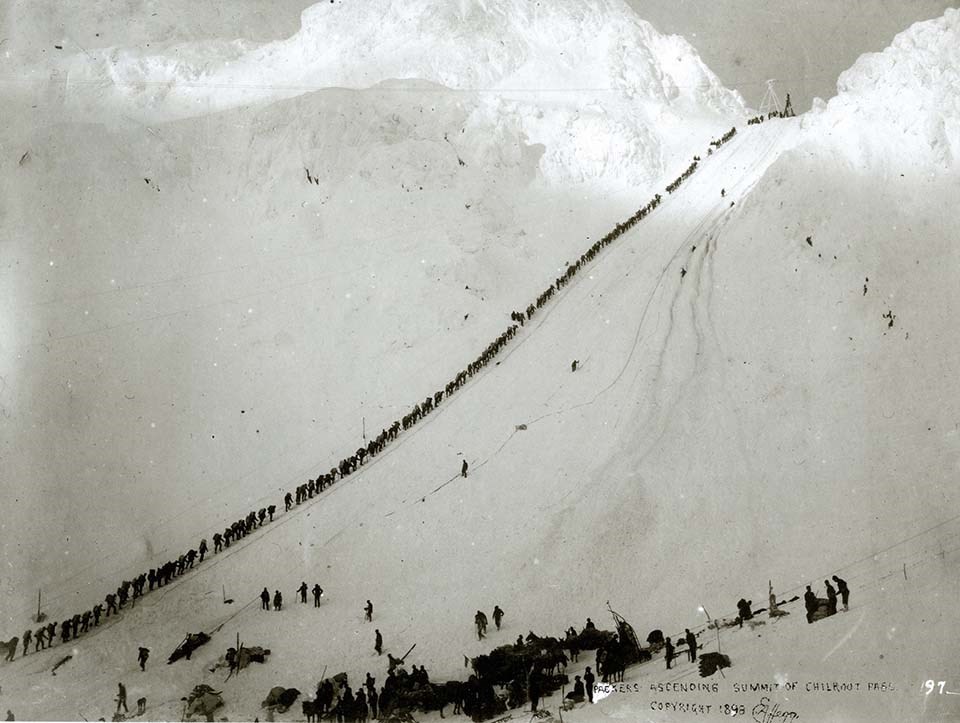
NPS /Library of Congress, USZ62-28477
People have been migrating into and through Alaska for over 14,000 years (Tremayne 2018). The last major migration into Alaska began with the Russian colonialism in the mid-late 18th century and intensified with the arrival of Euro-American traders, missionaries, and prospectors in the mid-late 19th century. The Klondike Gold Rush from 1896-1899 was a particularly intense, but brief, wave of migration that would forever change the course of history for Alaska. Klondike Gold Rush National Historical Park, located in southeast Alaska in the town of Skagway (Figure 1), was founded with the mission to preserve and interpret the story of the prospector’s lives, including the routes and modes of transportation by which the men and women took to get to the gold fields.
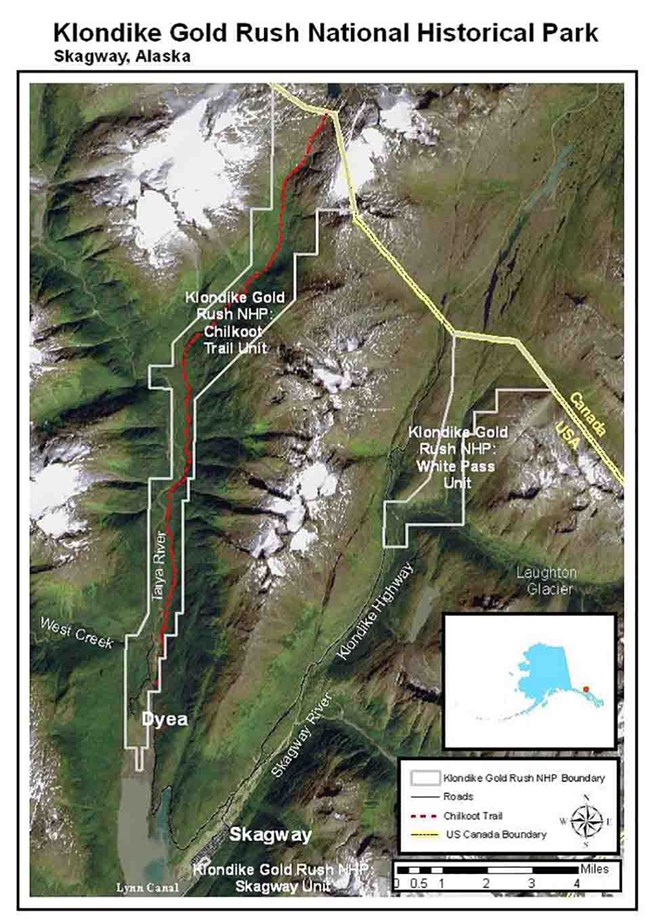
As part of its mission, National Park Service (NPS) archaeologists routinely survey the park to inventory and assess the condition of the resources. In 2016 and 2017, park archaeologists initiated a project to assess the cultural resources preserved along the Chilkoot Trail, one of the primary routes prospectors used to access the gold fields. By necessity, migration requires the transportation of goods and supplies. While new discoveries were limited, this project documented a handful of artifacts that preserve the various transportation methods into Alaska including foot power, pack animals, tramways, and even boats.
Historical Background
The Klondike Gold Rush began in August 1896 when Skookum Jim Mason, Dawson Charlie, and George Washington Carmack discovered gold in a tributary of the Klondike River in Canada’s Yukon Territory. From 1897 to 1898, thousands of stampeders poured into southeast Alaska with dreams of gold and riches across the mountains in the Klondike (Neufeld and Norris 1996). Between 1890 and 1900, the United States Census showed a dramatic increase in the Alaska population, which grew from 32,035 to 63,592 in less than ten years (Ducker 1994). This population boom resulted in the establishment of mines, trading posts, homesteads, and boomtowns, which dramatically increased interactions between Alaska Natives and immigrants.
With the sudden arrival of thousands of men, the small tent cities of Skagway and Dyea grew to be prosperous outposts. Dyea boomed at the foot of the Chilkoot Trail just as Skagway did at the foot of the White Pass Trail, two of the primary transportation routes to the gold fields. According to historians, most of the prospectors were young men from the western United States and Canada, but there were foreign-born immigrants from as far away as Scandinavia and China drawn to the region (Ducker 1994). Wealthier entrepreneurs, including supply outfitters, saloon owners, entertainers, and others in the service industry, also arrived en masse ready to capitalize on the needs of the miners (Neufeld and Norris 1996).
The Chilkoot trail, beginning at Dyea, is a 33-mile-long route that climbs 3,500 feet into the mountains over a pass into the Yukon Territory of Canada (Figure 1). The Tlingit people had used this trail and other passes in the region for thousands of years as a way to get from the coast to the interior to trade with Athabaskans (Neufeld and Norris 1996). The presence of obsidian sourced to Mount Edziza in British Colombia from a 10,000-year-old coastal site in southeast Alaska (Dixon 2001), indicates coastal people must have exploited such routes to the interior as soon as the glaciers retreated at the end of the ice age. As the Chilkoot Pass is not a particularly hospitable location for a village, the expectations are that most of the pre-contact site types reflect short-term, ephemeral camps and hunting stations. Historic era sites, on the other hand, preserve objects related to mining and the transportation of goods through the pass.
In 1898, hopeful prospectors literally marched in single file lines up the long pass, making many trips to haul the thousands of pounds of supplies they needed to outfit their expeditions; for once they made it over the pass, these men still had to build boats to float down the Yukon River to get to the gold fields. A number of the wealthier stampeders sent their outfits over by tramway, a major engineering feat for its time. Others of more humble means used pack animals to haul their loads on the journey from Dyea to Lake Bennett in the Yukon; however, many simply carried their gear on their backs. At times, their burdens became too great to bear, for man and beast, and wearied travelers jettisoned gear and left their exhausted pack animals behind.
In the Prospectors Steps
The prospectors hiked through the Chilkoot Pass as quickly as possible. One-hundred and twenty years later, archaeologists with the National Park Service hiked the pass slowly to carefully scour the trail for traces of this historic migration. In spite of the thousands of people that traversed the Chilkoot Pass, historic debris does not litter the trail. Instead, artifacts are rare and often concealed, requiring a careful eye and attention to detail to locate them. Over a century of harsh weather, vegetation growth, and sediment deposition has a way of breaking archaeological materials down and obscuring artifacts that were once on the surface.
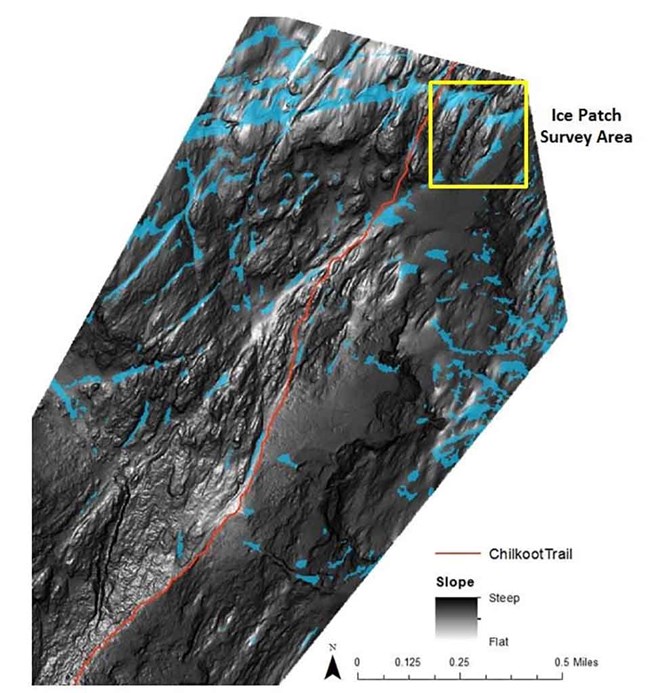
The survey area for the 2016-17 project focused on ice patches and lichen-free zones from recently melted ice patches located in the alpine environment of the Chilkoot Pass south of the Canadian border (Figure 2). Ice patch archaeology from the Yukon and Alaska has already provided a great deal of information on subsistence hunting and prehistoric weaponry (Dixon et al. 2014, Hare et al. 2004). Ice patches are widely known for preserving ancient hunting tools because hunters would target caribou and other animals that used ice patches to gain respite from heat and insects (VanderHoek et al. 2012). One of the goals of the project was to determine if historic artifacts related to the Klondike Gold Rush would likewise be well preserved thanks to the deep snowpack and ice.
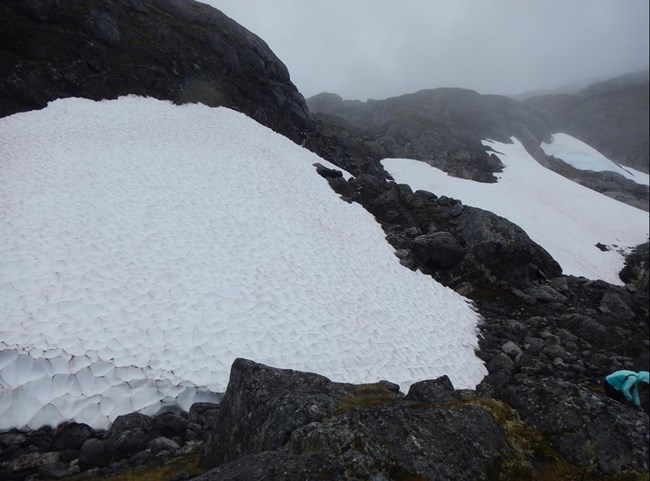
NPS/Corrine Michel
The survey methods involved teams of archaeologists scouring the ground for any objects that were not part of the natural environment. Once in the pass, the team explored the margins of melting snow patches for preserved organic artifacts (Figure 3). If an artifact was located, the archaeologists recorded the precise locations with GPS devices, took photographs, and wrote down notes to document the setting and objects found (Rankin et al. 2017). The team also revisited known sites to assess the condition of artifacts. One goal of park cultural resource management is to preserve in situ historic objects along the Chilkoot Trail. When threats or disturbances at sites are noted, park archaeologists seek solutions for ways to mitigate the damage.
Survey Results and Interpretations
The results of the Chilkoot Trail survey included the discovery of three new historic archaeology sites, one possible pre-contact site, and the condition assessment of one well-known, historic site (Rankin et al. 2017). The known site is unique and somewhat strange, for this site preserves the remains of wood and canvas supplies to build a number of “knock-down boats” (Figure 4A) that one prospector had hauled to the top of the pass only to abandon once he got there. We do not know the reason for the remains of the boats at the summit. However, there are several theories, the most plausible being that crews hauled them to the top of the pass for the “Flowers, Smith and Company” only to be abandoned once they reached the summit (Norris 1983). It is likely that Canadian officials refused their entry into the country due to safety concerns of these boats breaking up and killing their passengers during the journey over the Yukon River (Norris 1983). These wood planks, still wrapped in canvas at the top of Chilkoot Pass, are a tangible reminder of the importance placed on water transportation to move their supplies to Whitehorse, Dawson, and into Alaska, but also that sometimes the project failed even before making it to the rivers.
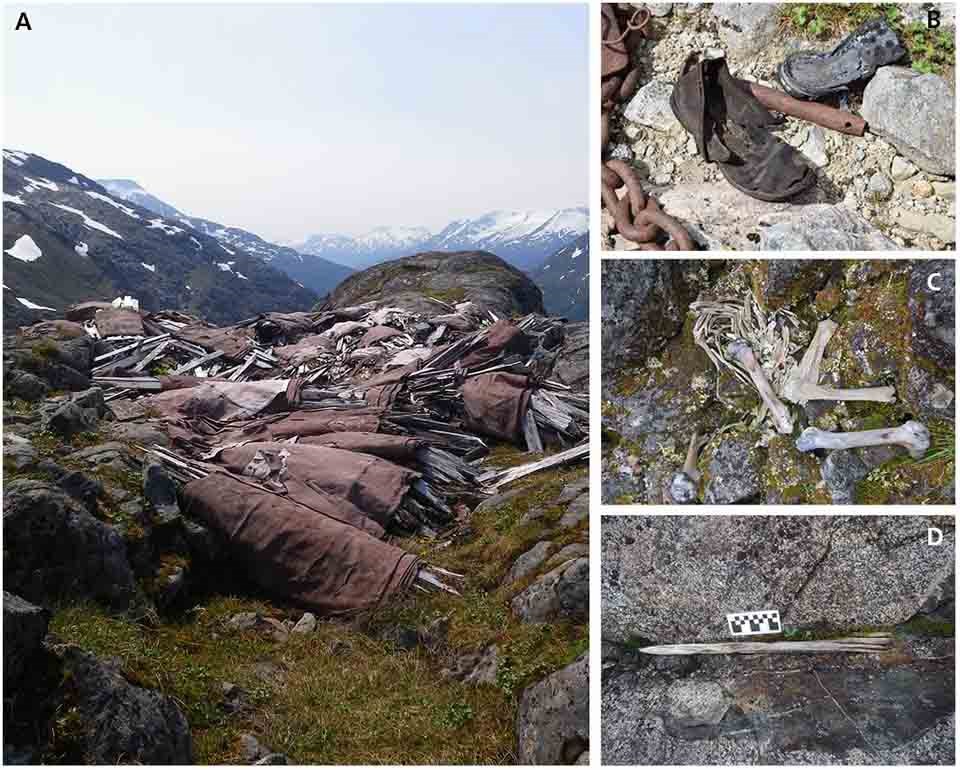
(C) Skeletal remains of an ox that died while crossing the pass. (D) A modified wood implement, possibly part of an ice probe left behind by pre-gold rush explorers.
NPS/Shawn Jones
At one of the newly discovered sites, the archaeology team recorded heavy chains and hardware (Figure 4B) related to a trail-length tram used to haul supplies up the pass (Neufeld and Norris 1996). The tram system, one of five built in the region, was erected in 1894. (It should be noted that people were using the pass and moving into the Yukon prior to the 1896 discovery at Bonanza Creek. As such, the hauling of gear across the pass was big business even before the main thrust of the Klondike Gold Rush occurred). Prior to the construction of the trams, many companies employed Tlingit men and women to carry loads on their backs through the pass, but by the end of 1898, the tramway and pack animal caravans caused most of these jobs to disappear (Neufeld and Norris 1996).
At this same site, the team discovered a worn-out pair of shoes, presumably lost by a prospector (Figure 4B). Articles of clothing are typically rare to find in the archaeological record and are interesting for many reasons. Every person required good shoes for their journey, but some failed to make it to their ultimate destination. What happened to the owner of these shoes? Did they simply drop an extra pair, or did the owner meet a more tragic fate? Many of the prospectors died in the pass, including nearly 70 people in a single avalanche (Neufeld and Norris 1996). We can only speculate about the individual who owned these shoes, but the presence of this historic artifact inspires us to imagine what that individual’s life must have been like.
As noted above, stampeders used horses, mules, and even oxen as pack animals to haul supplies through the Chilkoot Pass (Neufeld and Norris 1996). The steepness and ruggedness of the Chilkoot Trail took its toll on some of the animals and they were shot and left behind. This project discovered the bones of one oxen—that apparently met its fate at this time—scattered among some boulders in the pass (Figure 4C). As with the old, worn-out shoes, there is little monetary value in finding the bones of a long-dead animal, but the story that these bones verify is that the journey into the gold fields could be perilous for both men and beasts alike. Additionally, the bones provide a concrete link to the past events, preserving the empirical evidence that allows us to revisit this historical event from a more personal, individualistic perspective.
In addition to the Klondike Gold Rush-era sites that were discovered and revisited, the NPS crew also discovered a wooden artifact (Figure 4D), most likely an ice probe for travel over glaciers and snow, which was radiocarbon dated to 140 years before present. The date suggests Tlingit or Athabaskan people probably left it behind a few decades prior to the Gold Rush. This artifact is an excellent reminder that the prospectors of 1898 were not the first people to pass through this area, but there were people that had long used this route to travel between territories. More work is needed doing ice-patch surveys in adjacent areas to document the prehistoric sites that surely must exist here.
Conclusions
While a great deal of archaeological work has documented the historic camps at Skagway, Dyea, and in the Yukon Territory (Neufeld and Norris 1996), archaeologists have completed only a small portion of possible survey and documentation of historic resources related to the Klondike Gold Rush in the Chilkoot Pass itself. Each new survey, including this project that focused on areas in the pass where thawing ice patches are present, results in the discovery of some preserved artifacts and new evidence with which to interpret this historic migration event.
Considering the nature of the artifacts in the Chilkoot Pass within the theme of migration, we can discuss at least four lines of evidence for mobility: foot power, pack animals, tramways, and boats. Each tells a story about transportation and mobility. Most men walked (and sometimes lost their shoes), others used pack animals or transported goods using tramways, and almost all relied on boats to haul gear down river into the Yukon and Alaska. Considering the location of these artifacts and features high on the Chilkoot Pass, it drives home the point that this was a difficult and arduous journey.
For many immigrants to the Yukon and Alaska, the Chilkoot Pass was the gateway to their new homeland. To cross the pass signified the departure from the familiar and the entry into a new land where untold fortunes awaited. The reality of the harsh climate and the competition with hordes of prospectors racing to the gold fields crushed many a stampeders’ dreams, but ushered in the era of colonialism that would eventually affect the lives of all Alaskans, indigenous or migrant. While many of the prospectors were transient, others stayed behind to create the trading outposts, hotels, restaurants, and taverns. Many of the Gold Rush boomtowns are today major Alaskan and Canadian cities, while others, such as Skagway, are living museums, preserved for the enjoyment of tourists. The Chilkoot Trail remains a challenging hike. Today, about 2,000 adventurous hikers a year experience its grandeur and history (compared to the gold rush peak when the trail was used by 1,000 people each day). For those who go, there is still opportunity to discover some of the objects left behind by the Stampeders and it is the goal of the National Park Service to preserve and share this amazing story of migration.
REFERENCES
Dixon, E. J. 2001.
Human colonization of the Americas: timing, technology and process. Quaternary Science Reviews 20(1): 277-299.
Dixon, E. J., M. E. Callanan, A. Hafner, and P. G. Hare. 2014.
The emergence of glacial achaeology. Journal of Glacial Archaeology 1(1): 1-9.
Ducker, J. H. 1994.
Gold Rushers north: A census study of the Yukon and Alaskan Gold Rushes, 1896-1900. Pacific Northwest Quarterly 85(3): 82.
Hare, P. G., S. Greer, R. Gotthardt, R. Farnell, V. Bowyer, C. Schweger and D. Strand. 2004.
Ethnographic and archaeological investigations of alpine ice patches in southwest Yukon, Canada. Arctic 57(3):260-272.
Neufeld, D. and F. Norris. 1996.
Chilkoot Trail: Heritage route to the Klondike. Whitehorse, Yukon: Parks Canada, Department of Canadian Heritage.
Norris, F. 1983.
Knockdown boats, National Park Service archives.
Rankin, C., C. Mog and S. Jones. 2017.
Parkaeology and climate change: Assessing the vulnerability of archaeological resources at Klondike Gold Rush National Historic Park, Alaska. Archaeological Review from Cambridge 32(2): 56-77.
Tremayne, A. 2018.
A survey of human migration in Alaska’s national parks through time. Alaska Park Science 17(1): 8-19.
VanderHoek, R., E. J. Dixon, N. L. Jarman, and R. M. Tedor. 2012.
Ice patch archaeology in Alaska. Arctic 65(1): 153-164.
Last updated: June 3, 2021
